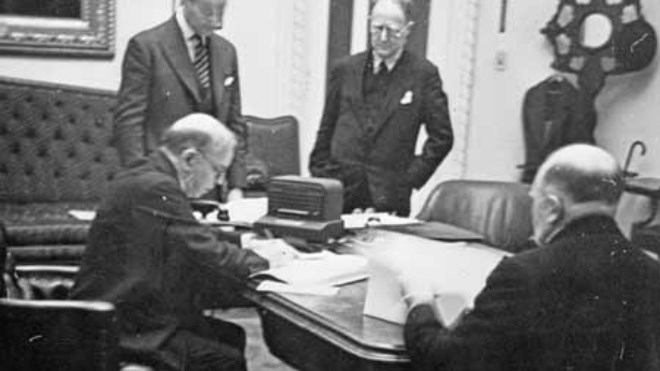OrilliaMatters welcomes letters to the editor. This letter is a reflection on the global pandemic and how leadership in Canada compares to the Second World War. Send your letters to [email protected]
********************
There has been much comment recently comparing the coronavirus epidemic to the challenges of war.
More particularly to the Second World War, when, a country of 11,000,000, Canadians put their shoulder to the wheel to become an industrial powerhouse producing a hard-to-imagine volume of armaments, while supporting 1.1 million of its citizens in uniform.
Can this effort be replicated in the fight against Covid 19?
The economic circumstances in the current war against the virus are very different than those that prevailed during the Second World War. In fact, they are upside down.
In September 1939 the economy was still weighed down by the Great Depression with unemployment high. As the war progressed more and more Canadians were drawn into the labour force, total economic output doubled by 1945, and by war’s end most Canadians were much better off financially than they had been in 1939. It was an economy placed on steroids for over five years.
By contrast, our economy today has been placed into an induced coma. Many businesses have had to shut down, and workers in non-essential employment have been idled. And this in a matter of weeks, not years.
During the Second World War taxes of all kinds increased dramatically and the government borrowed heavily. By 1945 Ottawa’s debt was greater than 100 per cent of GDP.
The latest update from The Parliamentary Budget Officer (PBO), released April 7, which takes into account all announced transfers from the federal government to individuals and businesses, projects a 2020-21 deficit of $184.2 billion, or 8.5 per cent of GDP, and a debt to GDP ratio of 41.4 per cent. Still a long way from the 1945 debt to GDP ratio of greater than 100 per cent, and even the 66.6 per cent experienced as recently as 1995-96.
The PBO assumes in its projections that physical distancing and self-isolation measures will remain in effect for six months through August.
The numbers indicate that Canadians are still somewhat distant from the degree of sacrifice that was required on the home front during the Second World War. But what if the situation became more dire?
Early indications are positive from the perspective of Canada’s citizenry.
Canadians by and large are abiding by the stay-at-home request. Medical personnel and other frontline essential workers are stepping up, much as our soldiers, sailors and air crew did at the sharp end during the Second World War.
Heartening also are the various initiatives coming from the private sector proposing or putting into action measures to retool shop floors so they can produce needed medical and protective gear.
What about leadership from our elected representatives and senior officials? Judgement is best left to a later date.
But at least our leaders today do not face a nation as divided as Canada was when it prosecuted its Second World War effort.
Historians Jack Granatstein and Dean Oliver write in The Oxford Companion to Canadian Military History that in 1939 the memory of the terrible casualties of the First World War hung heavily over the country, and in Quebec the scars of the 1917 conscription crisis were still fresh.
Throughout the war Prime Minister Mackenzie King had to bob and weave his way between a jingoistic English Canada and an isolationist Quebec. Somehow this uncharismatic man, whose bizarre private life remained private then, kept the country together, and is today viewed as one of our great prime ministers.
King had help from some strong cabinet ministers and a quick thinking civil service. Production bottlenecks: create a crown corporation. Some 28 crown corporations were set up during the Second World War. Management not up to the task: put someone else in pronto.
Lessons about leadership and perseverance can be gleaned from that time. Perhaps that’s the insight that can be gained from holding up that mirror of our history.
Those interested can find Granatstein and Oliver’s excellent 10-page summary on the Canadian Second World War Home Front effort here.
Anderson Charters was an Executive Producer of the television series, No Price Too High, Canadians and the Second World War, as well as a former community newspaper publisher and editor in Orillia.
********************



